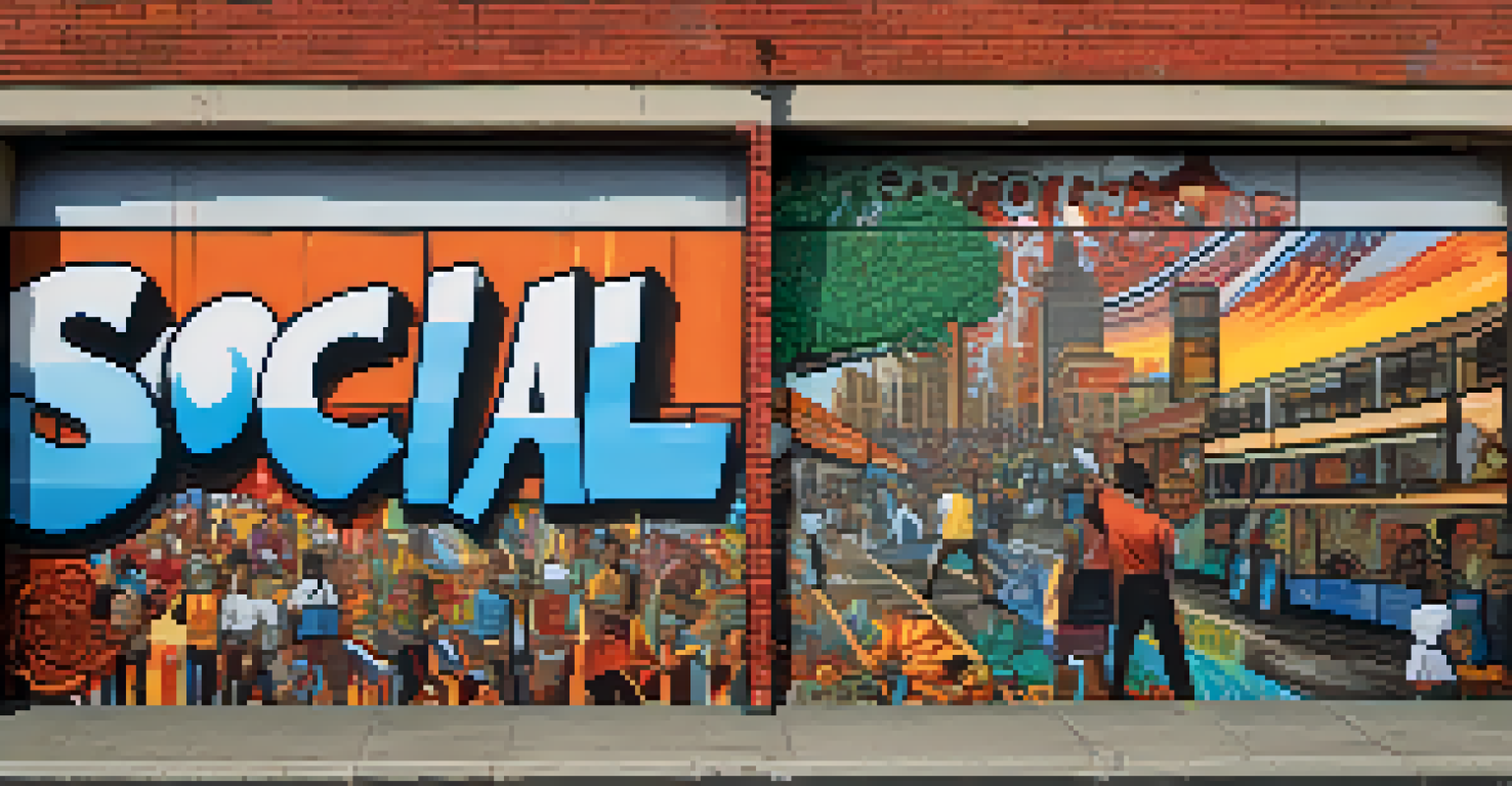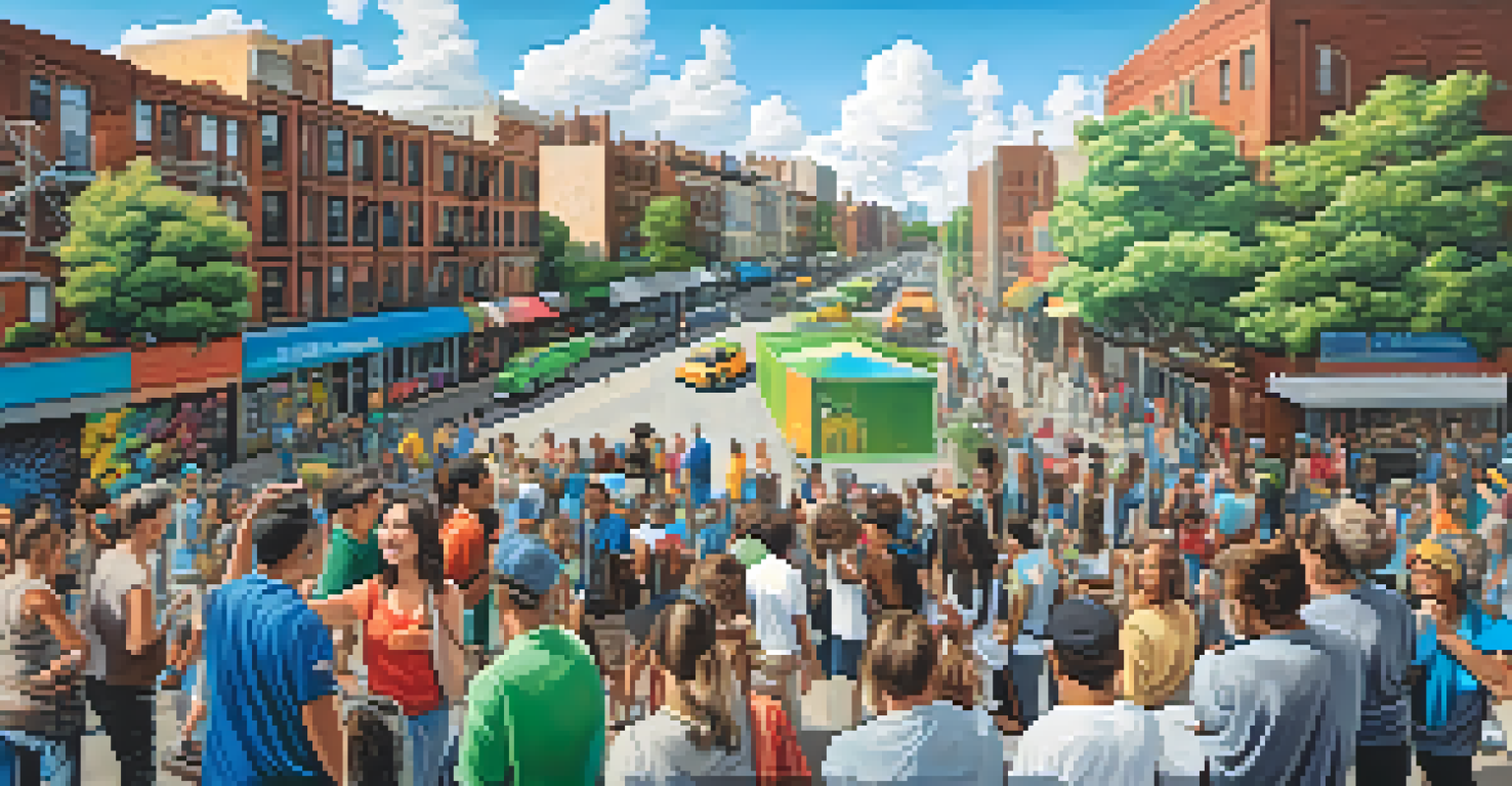The Impact of Street Art Festivals on Local Communities

Street Art Festivals: A Canvas for Community Expression
Street art festivals serve as vibrant platforms for local artists to showcase their work and express cultural narratives. These events transform ordinary spaces into extraordinary canvases, allowing communities to engage with art in a dynamic way. The murals created often reflect local history, social issues, or collective aspirations, making art a medium for storytelling.
Art is not what you see, but what you make others see.
Moreover, the collaborative nature of these festivals fosters a sense of belonging among residents. As artists and community members come together, they share ideas and perspectives, creating a tapestry of voices that enriches the local culture. This collaborative spirit helps to build stronger community ties and encourages participation from diverse groups.
In this way, street art becomes more than just decoration; it becomes a reflection of the community's identity and values. By celebrating local talent and fostering expression, festivals not only enhance public spaces but also instill pride among residents.
Boosting Local Economies Through Arts and Culture
One of the most tangible impacts of street art festivals is their ability to boost local economies. These events attract tourists and art enthusiasts who spend money on accommodations, food, and local businesses. The influx of visitors can significantly increase revenue for shops, restaurants, and hotels, creating a ripple effect throughout the community.

Additionally, local artisans and vendors often have the opportunity to showcase their products at these festivals. This not only provides them a platform to reach new customers but also encourages the community to support local initiatives. By fostering a thriving arts scene, street art festivals can help create lasting economic benefits.
Art Festivals Boost Local Economies
Street art festivals attract tourists and promote local businesses, creating a significant economic impact.
In essence, these festivals act as catalysts for economic growth, demonstrating that investing in culture can yield substantial returns. Communities that embrace street art often discover new avenues for development and prosperity, proving that art and economy can go hand in hand.
Creating Inclusive Spaces for Diverse Voices
Street art festivals often prioritize inclusivity, making them accessible spaces for diverse voices. By inviting artists from various backgrounds, these events celebrate the richness of different cultures and experiences. This inclusivity not only diversifies the artwork but also invites a broader audience to engage with the festival.
The greatest art is the most beautiful expression of the most beautiful feelings.
As communities gather to share in this celebration of art, they cultivate environments where dialogue and understanding can flourish. Attendees can discuss the meanings behind the artwork and the stories of the artists, creating a deeper connection to the pieces. This exchange of ideas can lead to greater empathy and appreciation among community members.
Ultimately, the emphasis on inclusivity in street art festivals helps to break down barriers and foster a sense of unity. These events remind us that art is a universal language that can bridge gaps, bringing people together in celebration of their shared humanity.
Revitalizing Urban Spaces Through Art
Street art festivals play a crucial role in revitalizing urban spaces that may have been neglected or underappreciated. By transforming dull walls and forgotten corners into vibrant murals, these festivals breathe new life into the community. This artistic transformation not only enhances the aesthetic appeal of the area but also fosters a sense of ownership among residents.
Investing in public art can significantly change perceptions of a neighborhood. What was once seen as a barren or uninviting space can quickly become a focal point of creativity and vibrancy. This shift can attract new residents and businesses eager to be part of an emerging cultural hub.
Inclusivity Fosters Community Unity
By celebrating diverse artists and cultures, street art festivals create inclusive spaces that enhance community bonds.
Moreover, revitalized urban spaces can host additional events and activities, further enriching community life. The positive impact of street art often extends beyond the immediate area, fostering a culture of appreciation for public art that benefits everyone.
Encouraging Youth Engagement and Development
Street art festivals often include programs specifically designed to engage youth, providing them with opportunities to learn and grow. Workshops and mentorship programs led by professional artists can inspire a new generation of creators. This hands-on involvement allows young people to explore their artistic talents while gaining valuable skills.
Engaging youth in creative endeavors also promotes self-expression and confidence. Through the process of creating art, they can explore their identity and share their perspectives with the world. This empowerment can lead to increased community involvement as young people feel they have a voice worth sharing.
In nurturing the artistic potential of youth, street art festivals contribute to long-term benefits for the community. By investing in the next generation, these events help cultivate future leaders and innovators who will continue to shape the cultural landscape.
Fostering Cultural Tourism and Global Connections
Street art festivals have the potential to attract cultural tourism, drawing visitors from far and wide to experience the unique art scene. As these events gain recognition, they can become focal points on travel itineraries, showcasing the city’s creative spirit. Tourists seeking authentic experiences are often drawn to the local culture, making street art festivals an exciting destination.
This influx of cultural tourism can also lead to global connections, as artists and attendees share their experiences online. Social media allows for the rapid spread of ideas and inspiration, linking communities across borders. Through this connectivity, street art can transcend geographical boundaries, fostering a global appreciation for local artistry.
Street Art Raises Social Awareness
These festivals serve as platforms for artists to address vital social issues, sparking important community conversations.
Ultimately, street art festivals enrich not just the local community but also extend their impact on a global scale. By showcasing local talent and inviting international visitors, these events create a vibrant exchange of culture that benefits everyone involved.
Promoting Awareness of Social Issues Through Art
Street art has long been a medium for social commentary, and festivals often provide a platform for artists to address pressing issues. By highlighting themes such as inequality, climate change, or mental health, artists can provoke thought and inspire action within the community. These powerful messages can resonate with audiences, fostering discussions that might not occur otherwise.
Through the visual impact of murals, street art festivals can effectively raise awareness and spark conversations around important topics. Art can be a catalyst for change; when people see their realities reflected in public spaces, they may feel compelled to engage and advocate for solutions. This engagement can lead to meaningful community discussions and collaborations.

In this way, street art festivals not only beautify a community but also encourage critical thinking and social engagement. By promoting awareness of social issues, these events become a platform for positive change, inviting everyone to participate in the conversation.